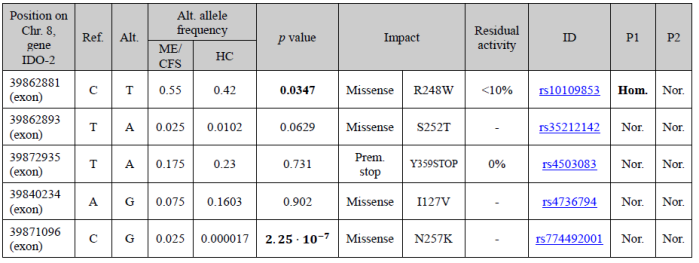what are the four mutations on the IDO2 gene that Dr Phair is referring to?
==
https://www.mdpi.com/2075-4418/9/3/82
Abstract
Myalgic encephalomyelitis/chronic fatigue syndrome (ME/CFS) is a debilitating noncommunicable disease brandishing an enormous worldwide disease burden with some evidence of inherited genetic risk. Absence of measurable changes in patients’ standard blood work has necessitated ad hoc symptom-driven therapies and a dearth of mechanistic hypotheses regarding its etiology and possible cure. A new hypothesis, the indolamine-2,3-dioxygenase (IDO) metabolic trap, was developed and formulated as a mathematical model. The historical occurrence of ME/CFS outbreaks is a singular feature of the disease and implies that any predisposing genetic mutation must be common. A database search for common damaging mutations in human enzymes produces 208 hits, including IDO2 with four such mutations. Non-functional IDO2, combined with well-established substrate inhibition of IDO1 and kinetic asymmetry of the large neutral amino acid transporter, LAT1, yielded a mathematical model of tryptophan metabolism that displays both physiological and pathological steady-states. Escape from the pathological one requires an exogenous perturbation. This model also identifies a critical point in cytosolic tryptophan abundance beyond which descent into the pathological steady-state is inevitable. If, however, means can be discovered to return cytosolic tryptophan below the critical point, return to the normal physiological steady-state is assured. Testing this hypothesis for any cell type requires only labelled tryptophan, a means to measure cytosolic tryptophan and kynurenine, and the standard tools of tracer kinetics. View Full-Text
==
https://www.mdpi.com/2075-4418/9/3/82
Abstract
Myalgic encephalomyelitis/chronic fatigue syndrome (ME/CFS) is a debilitating noncommunicable disease brandishing an enormous worldwide disease burden with some evidence of inherited genetic risk. Absence of measurable changes in patients’ standard blood work has necessitated ad hoc symptom-driven therapies and a dearth of mechanistic hypotheses regarding its etiology and possible cure. A new hypothesis, the indolamine-2,3-dioxygenase (IDO) metabolic trap, was developed and formulated as a mathematical model. The historical occurrence of ME/CFS outbreaks is a singular feature of the disease and implies that any predisposing genetic mutation must be common. A database search for common damaging mutations in human enzymes produces 208 hits, including IDO2 with four such mutations. Non-functional IDO2, combined with well-established substrate inhibition of IDO1 and kinetic asymmetry of the large neutral amino acid transporter, LAT1, yielded a mathematical model of tryptophan metabolism that displays both physiological and pathological steady-states. Escape from the pathological one requires an exogenous perturbation. This model also identifies a critical point in cytosolic tryptophan abundance beyond which descent into the pathological steady-state is inevitable. If, however, means can be discovered to return cytosolic tryptophan below the critical point, return to the normal physiological steady-state is assured. Testing this hypothesis for any cell type requires only labelled tryptophan, a means to measure cytosolic tryptophan and kynurenine, and the standard tools of tracer kinetics. View Full-Text

